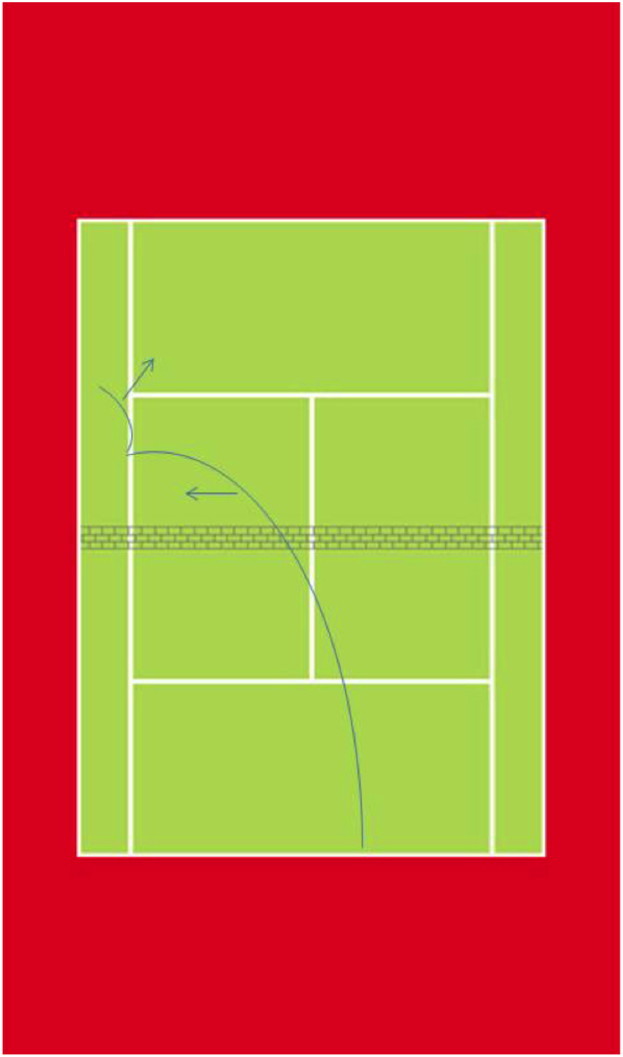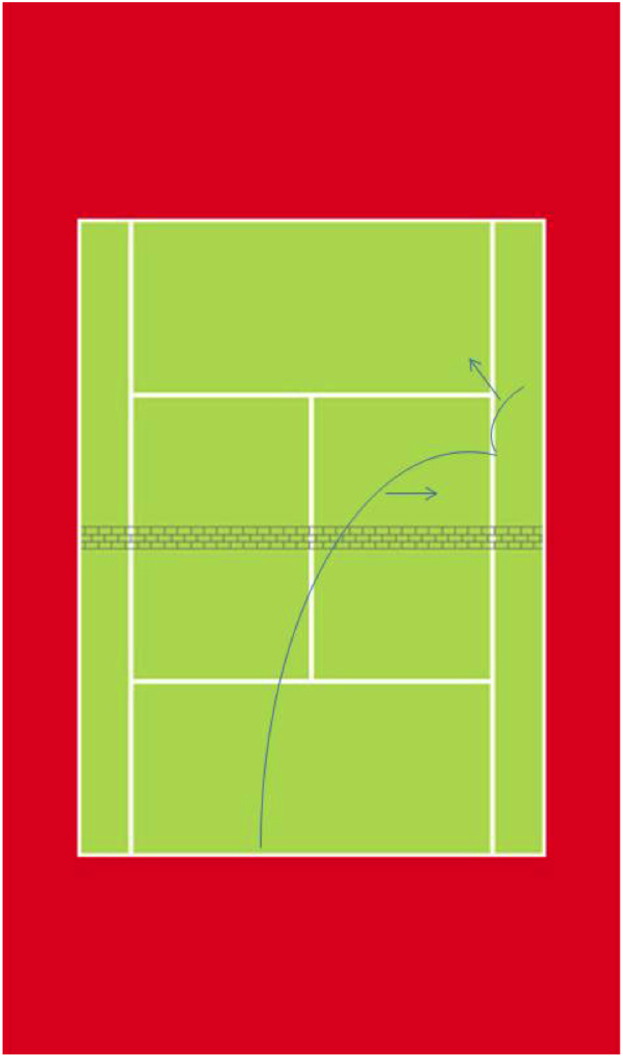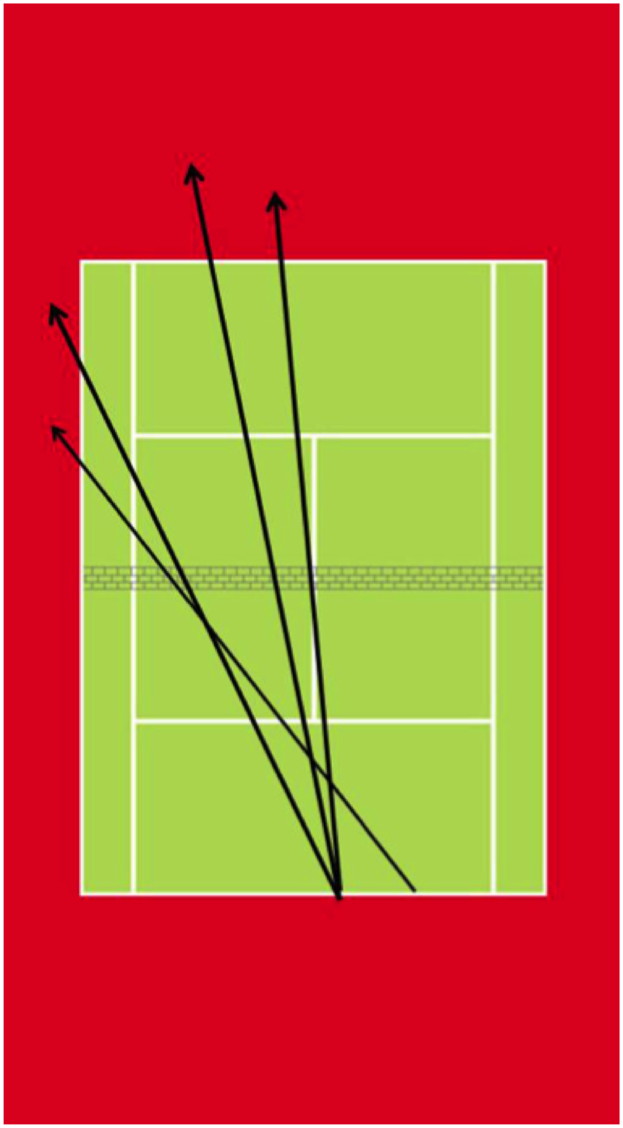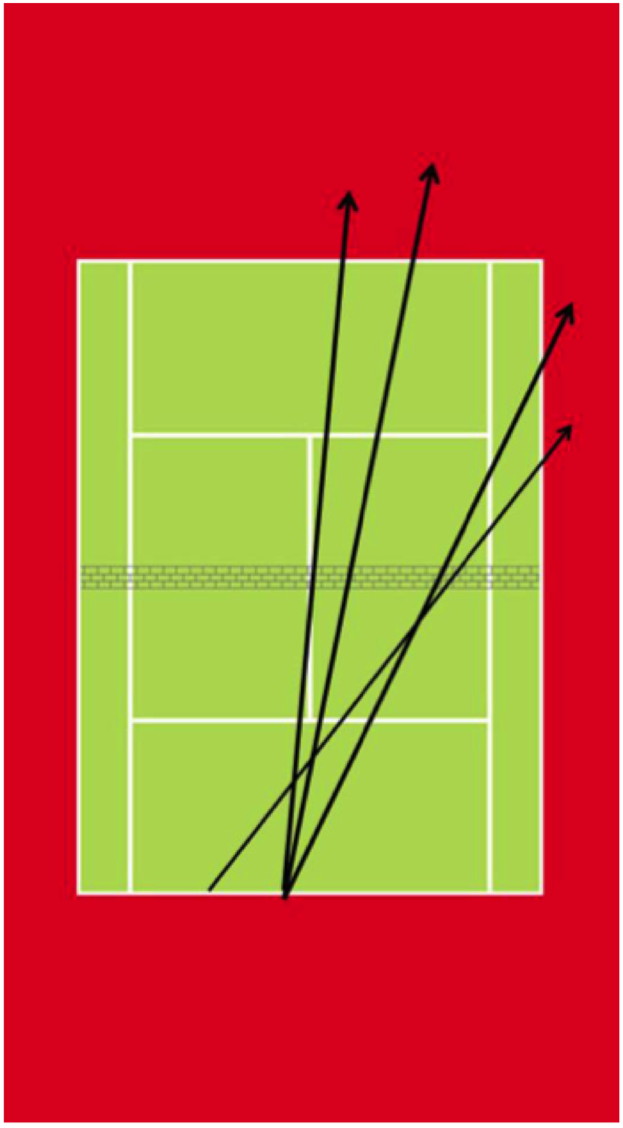 |

Turbo Tennis
May 2015
Article
Contact Ron Waite
Latest Turbo Tennis Article
Turbo Tennis Archives:
2003 - Present
1996 - 2002
Tennis Server
HOME PAGE
Do You Want To Be A Better Tennis Player? Then Sign Up For A Free Subscription to the Tennis Server INTERACTIVE
E-mail Newsletter!
 You will join 13,000 other subscribers in receiving news of updates to the Tennis Server along with monthly tennis tips from tennis pro Tom Veneziano.
You will join 13,000 other subscribers in receiving news of updates to the Tennis Server along with monthly tennis tips from tennis pro Tom Veneziano.
Best of all, it is free!
|
 |
TENNIS FEATURES: |
 |
TENNIS COMMUNITY: |
 |
EXPLORE THE TENNIS NET: |
|
 | |

 |
Service Strategy

Ron Waite, USPTR |
The single most important stroke in our wonderful game of tennis is the service!!!
The serve is the only stroke in our game where we are allowed two chances to get the shot right. It is the only stroke in our game that is not resulting from an on-coming ball. The serve is the only stroke in our game that is completely under our control.
Yet, players double fault at least once in almost every match. If one examines the service motions of players, they vary greatly. Indeed some year back Tennis Magazine had a contest for the world's most unorthodox or ugly service motion. Unfortunately, there were many contenders for this "honor."
Each of us has probably come to the realization that the serve is like the "free throw" in basketball. Errant serves can result from a bad mental frame of mind. If you have ever been serving and the thought entered your mind even briefly that you may miss the serve and/or double fault, you already know that this is likely to become the case. Basketball players share similar mental experiences when it comes to shooting "free throws" from the "line."
There are many factors that can make a serve go awry other than mental weakness or doubt. The wind and sun conditions can affect one's serve. A somewhat irregular and/or inconsistent toss can result in missed serves. Nerves and tension can interrupt the smooth flow of a proper serve motion.
Most of us spend lots of time practicing our serve... which is certainly necessary and desirable. We work on all the components: toss, motion, point of contact, follow through, etc.
We probably spend more time on practicing our first serve than our second serve. Unfortunately, this approach is ill founded, and really the opposite should be the case. After all, we are all only as good as our second serve.
We probably spend more time on pace than placement... more time on pace than imparting proper spin to our serves. In truth, aces are not all that common... especially among intermediate and recreational players. We would be far better off dedicating time to placement and spin.
However, I believe the most neglected part of the "service game" is having a strategy for employing our serves! We simply hit almost identical first and second serves around 80 percent of the time.
Well this month, I want to share with the reader some of my thoughts on putting together a simple strategy when serving. Even a rudimentary tactical approach to serving can pay big dividends in a match and actually improve the overall confidence of a player.
However, first things must come first. I must describe the kinds of serves that can exist in a player's arsenal. As I do, I am hoping that each reader will take inventory of her/his potential serves and expand the options to include all of the following.
THE FLAT SERVE
This is a player's most powerful serve. In striking the ball for the serve little spin is imparted. In truth, every ball hit has some spin. However, flat serves have the minimal amount. They travel through the air quickly, and usually are hit with a player's maximum or near maximum force. The pace of the flat serve can be intimidating when one faces a player with a "big first serve." It should be noted, however, that as a match progresses opponents become increasingly comfortable with even the biggest first serves. The pace becomes less intimidating. Flat serves have a more predictable bounce to them which also helps opponents "read" them better as the match moves forward.
Most players attempt a flat serve on close to 90 percent of their first serves. This is not completely foolish in that a strong, flat serve can elicit a weak service return. If placed carefully and deceptively, the flat serve can yield quite a few aces for a player. "Free points" are always a good thing. Still as a match unfolds, the flat serve probably becomes less of a weapon. Apart from the opponent becoming acclimated to this serve, balls become fluffy. This latter factor can slow down the pace of a serve due to the fact that there is more air resistance to the fluffier ball.
THE SLICE SERVE
Many modern players do not really learn and/or employ this serve! This is most unfortunate.
The slice serve is a serve where sidespin is imparted to the ball. This usually is a result of a racquet movement at the moment of impact where the racquet head moves away from the body of the server as an addition to the forward motion. The result is a serve that curves to one side as it travels through the air. This movement takes an arc-like trajectory. With right handed players, the arc of the ball as it travels through the air is to the left. With lefties, the spin causes the arc as the ball travels to move the ball to the right. However when the slice serve makes contact with the court, the spin forces a bit of an opposite effect. This latter facet is true for both lefties and righties.
Slice serves are great as both first and second serves!
I realize that this description is a bit confusing. So, here are some diagrams that hopefully will better show what I mean...
RIGHTHANDED SLICE SERVE TRAVEL PATH AND BOUNCE

LEFT HANDED SLICE SERVE TRAVEL PATH AND BOUNCE

In these diagrams, I have greatly exaggerated the amount of curving that occurs in both the ball's travel path and regarding the opposite direction of the ball after its bounce. It should be noted that the bounce change is more perceptual in nature.
Left handed players have been winning points in the ad court for centuries. In that only about 1 in 7 people are left handed, most players are familiar with "right handed" spins. The left handed slice serve to the ad court forces the receiver to move wide to return. The deceptive change in direction (slight as it may be) makes it difficult for the receiver to anticipate precisely where to make contact with the ball. Right handed players can always use their slice serves in a similar manner when serving to the deuce court. The only difference is that most players (both righties and lefties) are familiar with the spins associated with shots from right handed players. Again, it is important to realize that this difference is primarily perceptual and familiarity is born from frequency. There are simply more right handed players in our game.
THE PURE TOPSPIN SERVE
Topspin serves have forward spin or topspin imparted to the ball. A true topspin serve does not have any significant side spin associated with it. The ball can be hit very hard. The topspin will bring the ball down more quickly into the court just as is the case with any topspin shot. When bouncing, the topspin causes the ball to bounce higher than would normally be expected. Again, this is the same with any topspin shot.
Topspin serves are usually "safer" serves. They are a great option when attempting a second serve. Their higher bounce usually keeps the receiver back and elicits a somewhat less aggressive return. Thus, topspin serves often result in the beginning of a groundstroke rally.
THE KICK OR AMERICAN TWIST SERVE
On the pro tours, this is probably the most commonly employed second serve. Like the topspin serve, the kick (in the past referred to as the American Twist Serve) serve does impart significant topspin to the ball. The ball is therefore more likely to drop in the service box and will bounce high. However, the kick serve also imparts sidespin as is the case with the slice serve. Like the slice serve, the kick serve has a side motion to its travel path and when it bounces this sidespin is negated resulting in the perception of an opposite motion to the ball.
The combination of topspin and sidespin make the kick serve one of the most reliable and difficult serves to return... even when used as a second serve.
THE BACKSPIN SERVE
This serve does exist but is most uncommon. Indeed, it is not taught by any of the tennis organizations or academies. It is somewhat a "hacker's" serve. If a reader is truly interested in learning more about this serve shoot me an e-mail.
SERVE PLACEMENT
In my mind, serve placement is far more important than service pace! Don't get me wrong, a powerful serve that is hit with lots of pace can win points outright. But, a well placed serve that hits its "mark" can be equally effective.
Below, I have placed two illustrations that illustrate the typical serve directions (placements) that one should employ in a match.
It is imperative that in addition to learn all of the aforementioned serve type (save the backspin serve), each player should be able to hit every one of these serve types with reliability to each of these placement directions.
DEUCE COURT SERVE PLACEMENTS

AD COURT SERVE PLACEMENTS

You will note in both of these diagrams that I have the server positioned in or near the center of the court for three of these serve directions.
The fourth service direction is from a position that is more to the right in the deuce court and more to the left in the ad court. The purpose associated with these "off center" positions is to allow the server to hit a really wide serve.
If you are right handed and have a good forehand, hitting this very wide serve is not so dangerous. It will force your opponent to move wide, and the reply will more likely be to the center of your court or maybe down the line to your forehand. Either way, you have moved the opponent out of court. Assuming your forehand can be a weapon, you can hit a reliably reply and sometimes you can hit an outright crosscourt winner.
If you are left handed, the same logic applies when serving to the ad court.
CRAFTING A STRATEGY
Let's assume the ideal for a moment. You are in possession of good and reliable flat serve, slice serves, and kick serve. (If you can hit the pure topspin serve, all the better.)
Additionally, you are able to place each of these serves with authority to all four of the service directions listed above. Simple math should convince you that you have lots of options when serving! 3 different serves x 4 different serve paths x 2 different sides (ad and deuce) = 24 different serves!!!
Know your best combinations
Each of us has a preferred first serve and a preferred second serve. Generally, we may move our first serve around a bit during a match, but more often than not, we simply hit to what we perceive is the opponent's weaker wing.
Our second serve is almost always the same type of serve, and most certainly is hit more often to the backhand side in that we believe that this is normally the weaker wing.
You need to really know what are the "foundation" serves with which you feel most comfortable. When you are really under pressure or nervous, these are the "bread and butter" combinations that you need to draw upon for reliability. In a crisis situation, you want to be able to go to your best and most reliable serves!!!
Know or learn to know your opponent
If you are like many players, you are seeing the same opponents over and over again. Even the pros see each other and "know" each other. (Of course, their coaches have helped them to assess their opponents.)
If you are consistently finding yourself playing the same opponents, begin to "experiment" with different serves and placements. Make a mental record of what they like or do not like... what they expect or do not expect... where they are likely to return each different serve. As you learn the answers to these questions, make a written record of your findings for future matches. You really want to create a "scouting book" on every opponent you face. You are likely to see him/her again. This takes time, but if you are serious about winning, you will make the effort and find the time. Believe me; intimately knowing your opponents' games gives you an edge in every encounter!
If you are facing a new opponent, the probing needs to be done from scratch. You don't have any advanced information or insight to help you craft a service pattern. But, you can make note of what are the effects of each of your serves. In these cases, you probably will start with your preferred service combinations. This is fine and as it should be. But when the score is in your favor (e.g. 30-love, 40-15 or 40-love), don't be afraid to vary your pattern. For instance, try a slice serve as a first serve and see what results.
Maybe take a chance on a second serve and hit something that is either placed differently (e.g. to the opponent's body by hitting down the center) or once again, try a slice serve instead of a kick serve (assuming the kick is your normally preferred second serve).
As an anecdote, I recall a tournament match I played years back. I was facing a very competent opponent whom I had never played before. (He was actually from Germany.) He seemed to have a great return of serve and though I was not losing my service games, I was not really controlling the points on my serve. I was serving 30-love to the deuce court, and I decided to change my first serve which I had been hitting flat to a wide slice serve. My opponent had a full Western Forehand grip and was right handed. I discovered that he was not able to hit a solid return to this slice serve that pulled him out of the court. I continued to hit this wide slice serve every time I was serving to the deuce court throughout the match. Eventually, my opponent moved to his right in anticipation of this serve. I noticed his position, and of course, hit my first serve flat and down the T for an ace. By then, I owned this opponent when I was serving. Now, I had him thinking about where I would serve and what kind of serve I would put forth. I eventually won the match, but in truth, he was the better player. Had I not discovered a different service pattern, I suspect that my holding serve would have eventually fallen apart.
Some service tips
There is no single service pattern that is guaranteed to work! First, we are all different. So, one opponent has likes and dislikes that differ from another opponent's preferences.
But, there are some "tips" that I can share that may help you discover what pattern may work best in a given situation.
- Note what is the opponent's weaker wing. Hit more of your serves to this side. Just realize that sometimes it is very difficult to determine how weak a side may be. When the score is in your favor (40-love, 30-love, 40-15) don't be afraid to probe the stronger wing with a spin serve. Hit a second serve that has a different spin and or location. Make note of the effect of any changes.
- Run the turtle and hit at the rabbit. This adage applies to groundstrokes as well as to serves. If an opponent is fleet of foot, frequently one can have a successful serve that is directed at her/his body. "Jamming" the player who likes to move on the court can win you points. If the opponent is someone who seems to be fatigued or does not move well, wide serve and serve directly down the T can often times frustrate your opponent.
- One handed backhands generally do not like high bouncing serves. This is certainly not a universal truth, but is truer than you might imagine. If you are playing an opponent with a one handed backhand, topspin and kick serves usually result in weaker returns. Over the course of a long match, you can actually fatigue a player who has a one handed backhand by hitting lots of high bouncing balls to this side... including the serve. However, be prepared for the sliced return when the one handed player knows that a high ball is coming to his/her backhand wing. I have seen adept players who can actually hit a sliced return that comes close to being a drop shot. So, be cognizant of the opponent's setup as he/she prepares to hit a return.
- You cannot out hit the basher. Some players are just plain bashers. They have big groundstrokes and love to hit them with maximum pace. Feeding big flat serves to opponents of this type is a recipe for disaster. Far better to vary the pace, spin and placement of all your serves. The idea is to not allow this type of player to tee off on a return. Amazingly, a soft paced slice serve can be very difficult for this type of player. Pushers realize this intuitively and often times frustrate the basher into a loss.
- Every time you serve make sure you know what you are attempting to achieve. If you are hitting a big flat serve, why? If you are hitting down the T, why? Why hit a kick serve rather than a slice serve? Sometimes the reason for hitting a particular serve is that you feel most comfortable choosing it. If this is the case, no problem. Other times, you may be hitting a serve to vary your pattern and be less predictable. If so, this is fine. You may be hitting a particular serve to probe your opponent and see what kind of return you get. My point is simple, try to have a "reason" behind each serve. This is one way that you can keep your mind focused properly as you go through your service ritual. Add to this a visualization of the "perfect" serve, spin and placement... and you will rapidly find yourself controlling the points played off your serve.
- Work on deception. One of the things that impressed me most about Pete Sampras was that his service motion for every serve (and he had them all) was virtually identical. If you can learn to serve with the same motion for every serve, you will greatly enhance your level of deception when serving. When practicing serves, video yourself to see what "tells" you may be broadcasting to your opponents. With some work, you can minimize any "telegraphing."
- Anytime your opponent misses a return of serve, make note of it! You want to ask yourself the simple question, why was she/he unable to return the ball in bounds. Pay particular attention to those returns that your opponent hits into the net. These are the serious errors! If you over a match see that two identical serves (in terms of pace, placement and spin) are netted, you have spotted a clear weakness. Exploit this weakness without mercy!
- The serve should be an offensive shot. There are at least three ways in which it can be offensive in nature. First, the serve can be a challenge because of its pace, its placement, its spin or a combination of these. Second, the serve may be offensive in that it is unpredictable and is varied sufficiently. Third, serves are offensive when you never double fault. Imagine a match where you never double fault. Imagine a match where your first serve land in bounds at least 70% of the time. A consistent serve is worth at least 4 points in a three set match!!!
The serve is too important to neglect. It requires plenty of practice. A successful player almost always has an arsenal of serves and can draw upon this arsenal with confidence. Serves vary in terms of pace, placement and spin.
Knowing what your opponent likes and dislikes with respect to serves is important to know. So, is learning where and how an opponent tends to return a particular serve. It is well worth the time and effort to develop a written record of these preferences and likely returns.
Over time, you will begin to discover your own personal service strategy. You may change or alter tactics for different opponents or even during a match. Still, having a service strategy will go a long way toward helping you become a
tennis overdog!
  
Turbo Tennis Archives:
1996 - 2002 | 2003 - Present
If you have not already signed up to receive our free e-mail
newsletter Tennis Server INTERACTIVE, you can sign up here.
You will receive notification each month of changes at the Tennis
Server and news of new columns posted on our site.
|
This column
is copyrighted by Ron Waite, all rights reserved. Questions and comments
about these columns can be directed to Ron by using this form.
Ron Waite is a certified USPTR tennis instructor who took up the game
of tennis at the age of 39. Frustrated with conventional tennis methods
of instruction and the confusing data available on how to learn the
game, Ron has sought to sift fact from fiction. In his seven years of
tennis, Ron has received USTA sectional ranking four years, has successfully
coached several NCAA Division III men's and women's tennis teams to
post season competition, and has competed in USTA National singles tournaments.
Ron has trained at a number of tennis academies and with many of the
game's leading instructors.
In addition to his full-time work as a professor at Albertus Magnus
College, Ron photographs ATP tour events for a variety of organizations
and publications. The name of his column, TurboTennis, stems from his
methods to decrease the amount of time it takes to learn and master
the game of tennis.
|
 |
|

|





 You will join 13,000 other subscribers in receiving news of updates to the Tennis Server along with monthly tennis tips from tennis pro Tom Veneziano.
You will join 13,000 other subscribers in receiving news of updates to the Tennis Server along with monthly tennis tips from tennis pro Tom Veneziano. 



